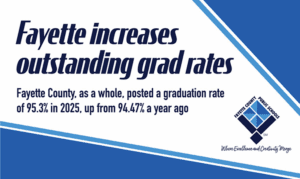The Fayette County School System is currently working off of a budget for the 2011-2012 school year that projected $170 million in revenues and more than $186 million in expenses. To date, the Fayette County Board of Education has approved Superintendent Jeff Bearden’s only recommended cut for the new school year that begins in July.
That leaves approximately $6.7 million that is expected to be cut in order to adopt a balanced budget in June. Bearden has stated on several occasions that those cuts will likely be coming in personnel. So what are some of the variables pertaining to personnel and the budget?
Before addressing the variables it should be noted that there may be somewhat of a silver lining to the upcoming budget considerations. That lining comes in the form of money currently being saved, essentially in personnel-related dollars, that puts the school system $4.3 million under budget as of January. With that in mind there is also the consideration that Fayette’s continued falling enrollment will mean upwards of $3 million fewer dollars coming from the state in the near term.
The need for discussions aimed at determining exactly what measures should be taken for the school board to be able to adopt a balanced budget in June for the 2012-2013 school year were the subject of comments last spring by Bearden and some on the board. Bearden and the board agreed that those discussions would begin during the summer of 2011. By his account, Bearden around that time said the school system would need to trim approximately $10 million in expenses in order to adopt a balanced budget for the 2012-2013 school year that begins this summer.
Then-Chairman Bob Todd months ago, and with the support of board member Marion Key, asked Bearden to have all recommendations ready for consideration prior to end of the 2011 calendar year so that board members would have sufficient time to review the proposals. Board member Janet Smola also made a request, asking that the recommendations come in the beginning of 2012.
One recommendation was forthcoming prior to the end of the calendar year. The school system conducted a survey on a number of topics that would reduce expenditures but the only recommendation forthcoming was in December to adopt a 177-day calendar at an annual savings of approximately $3.3 million. That, according to Bearden’s previous estimate, leaves approximately $6.7 million that must be cut to enable the board to adopt a state-required balanced budget sometime in June.
Bearden said his additional recommendations expected to total $6.7 million will come in the opening months of 2012. The balance of the needed cuts will likely come in the area of personnel, Bearden told board members on several occasions during the past few months.
Bearden may well be able to recommend making up the $6.7 million through personnel. The school system employs more than 3,000 people and loses a significant number of employees each year through conditions such as retirement or relocation. Despite the requests by some on the board, Bearden continues to hold his thoughts on the recommendations close to the vest.
Teachers usually think they will be the first to see cuts. And with falling enrollment that translates into teacher/student ratios, such a concern might be plausible to some extent. But there are also classroom parapros whose salary is largely paid by local dollars.
But what about some of the other areas that are not tied to the classroom?
• Non school-based personnel — Information supplied by the school system for the previous school year that ended on June 30 shows that of the more than 3,000 people employed, a total of 148 work in administrative, managerial, academic or support positions that are not located in schools. Those include locations such as central office and the Lafayette Education Center.
In total, the 148 positions generate $7.405 million in salaries. The positions fall into departmental categories such as Maintenance, Technology, Human Resources, Finance, Administration, Transportation, Testing, Special Education, Purchasing, Pupil Personnel Services, Instruction, Welcome Center or Student Assistance.
But it should be noted that eight of the 148 positions fall into the categories of After School Program and Nutrition, both of which generate revenues that pay the salaries of those employees. The salaries for the three After School Program staff total $151,502 while the salaries for the 5 Nutrition staff total $235,629.
That said, the remaining 140 positions receive $7.018 million in salaries from a combination of state and local sources. That sum translates to an average of $50,129 per person.
In terms of salary, there are five staff in the Fayette system making between $70,000-80,000, seven staff making $80,000-90,000 and 6 making $90,000-100,000. And there are 14 staff with salaries exceeding $100,000.
These individuals serve as department heads, academic or system coordinators and in upper administrative positions. The top three wage earners in the school system are the superintendent at $153,000, the deputy superintendent at $134,000 and the assistant superintendent at $126,000.
• Assistant Principals — The school system has 44 assistant principal positions in the 29 public schools, with two of those currently vacant, according to information obtained from the school system. State funding pays for 35.6 of those positions while the remaining 8.4 positions are funded by county property taxes.
Salary information obtained at www.open.ga.gov for Fiscal Year 2010, the most recent available, showed 40 of the current assistant principals listed. Their salaries, not including benefits, totaled $3.046 million.
Of the 40 assistant principals listed, the low was $62,500 while the high was $95,700, for an average of $76,150.
The 8.4 positions not funded by the state and reliant on local property tax dollars total $639,600 based on the $76,150 average.
• Bus drivers — Information supplied by the Fayette County School System showed that the system has a total of 284 buses and maintains 205 bus routes. The remaining 79 buses are either spares or surpluses.
Similarly, the school system employs 205 bus drivers. That number has sometimes been brought up in the past by members of the public in terms of potential cost saving measures since the Georgia Dept. of Education pays for only 92 of the 205 positions.
Bus drivers work part-time and are some of the lowest paid employees of the school system, with some working the positions to obtain health insurance. Bus drivers make in the range of $20,000 per year.
Fayette County school buses log approximately 1.72 million miles during the 180-day school year.
Asked about the school system’s special education buses, spokesperson Melinda Berry-Dreisbach said 45 of the buses are used for special education buses and, of those, 43 have monitors.
Pertaining to bus monitors, the school system maintains that, “Monitors are needed to care for the special needs students on their buses. The IEP (Individual Education Plan) requires a monitor. The bus driver needs help loading and unloading wheelchair-bound students. Pre-K students need help getting in their seat and being buckled up. Some students need guiding to their seat. The monitors watch for seizures and any unusual behavior. Just as the special needs teacher needs help in the classroom with the students, so does the bus driver on the bus.”
• Other school system employees — There are additional employees such as food service staff and custodians that are tied to school facilities and maintenance staff that serve the system as a whole.
Generally bringing in lower wages, the number of those staff are essentially tied to the number of school facilities operated by the school system.
That said, there was some discussion in the fall about closing two elementary schools, opening Rivers Elementary and closing one middle school to reflect the system’s decreasing enrollment and as a way to save precious dollars. The school system subsequently conducted a non-scientific community survey to determine the interest level on the idea.
The idea of closing one unnamed middle school had the agreement of 35.9 percent of respondents while 27.3 percent disagreed. Of those unsure, 21.9 percent leaned toward closure while 14.9 percent likely preferred the school remain open.
Closing one middle school would save approximately $1 million per year.
Another topic, that of closing two unnamed elementary schools and opening Rivers Elementary to its full capacity found more agreement than disagreement. Approximately 40 percent of respondents agreed with the closure and 19.3 percent were unsure but probably agreed. On the opposite side, 30.6 percent disagreed and 10.3 percent were unsure but probably disagreed.
Closing two elementary schools and opening Rivers would generate approximately $800,000 in savings.
And it was the idea of potentially closing two elementary schools that drew a number of people to the Sept. 19 meeting. Some of those took to the podium during the public comments portion of the meeting. Saying that they had heard their schools were being targeted for closure, members of the Tyrone and Brooks communities were insistent that their schools are an integral part of the respective communities and should not be targeted for potential closure.
There were also a number of other comments that accompanied that insistence. Brooks resident Donna New suggested that the survey was not clearly representative of the school system and should either be re-administered or disregarded.
Tyrone resident Melissa Hill questioned the county of residence of survey respondents. She said the schools in Tyrone and Brooks should remain open, adding that the more populated cities such as Fayetteville could handle the closure more easily than the smaller communities of Brooks and Tyrone.
Still others during public comments advocating for the schools in Brooks and Tyrone to stay open suggested taking back teacher’s recently restored pay and instituting a merit-based system for raises, eliminating positions at central office and not allowing out-of-county employees to bring their children to Fayette schools.
Yet another Brooks resident in advocating for her community’s school to remain open said that, if closed, her daughter would likely have to attend a Title 1 school (which receives federal assistance tied to lower income levels) and would be at risk.
Community survey notwithstanding and regardless any current or future financial need, the idea of closing any of the county’s schools will likely be met by significant opposition from a number of parents. Thus any conversation in that regard, as evidenced at the Sept. 19 meeting where one parent said she would work to unseat board members if her child’s school was closed, could quickly become a political hot potato. Meantime, qualifying for three school board seats will take place in April and Bearden has stated that he would like to hold off on talks concerning school closures.
But what about the dramatically shrinking school enrollment numbers that, if continued, will potentially make it necessary to close several schools?
As it turns out the school system lost another 719 students between December 2010 and December 2011.
The December figures put school system enrollment at 20,607 compared to the 21,326 students a year earlier. Put in perspective, Fayette County schools have not seen so few students in a decade.
The biggest hit came at the elementary and high school levels. Compared to the first week of December 2010, elementary schools lost a total of 311 students while the county’s high schools lost 307 students. Fayette’s middle schools, while faring better, still have 101 fewer students than the same time a year ago. Those numbers reflect a total loss of 719 students since this time December 2010.
A look at the numbers show elementary schools at the beginning of December with a total of 8,324 students. That compares to 8,635 students for the same time last year. Student enrollment at the county’s middle schools totaled 5,047 compared to the 5,148 students attending one year earlier. And at Fayette’s high schools enrollment fell from 7,543 a year ago to 7,236 at the beginning of December.
An enrollment projection study accomplished in 2011 showed Fayette schools losing approximately 1,650 students by 2021. If that scenario plays out the school system will be back at the enrollment levels seen around 2000 and will have effectively lost more than two decades of student enrollment growth.
As for the upcoming recommendations to cut an estimated $6.7 million from the expenditures side of the budget, the school board, school system employees and county taxpayers will have to wait until Bearden presents his ideas.
School system revenues come essentially from local and state dollars. Local property tax revenues have been sliding due to a diminishing tax digest while state dollars linked to student enrollment figures continue to fall as Fayette’s enrollment continues to shrink. Each student in the school system generates approximately $4,000, so every decrease of 250 students translates into a $1 million decrease in state funding.
The hope, of course, is that the results of the recession will be reversed and population growth, including that of school-age children, will once again be seen in Fayette County.












Leave a Comment
You must be logged in to post a comment.